Recent Fire Damage Posts
I Smell Gas – What Should I Do?
2/17/2022 (Permalink)
 SERVPRO is available 24/7, 365 days a year to help with any size fire or water loss.
SERVPRO is available 24/7, 365 days a year to help with any size fire or water loss.
I'm Getting A Whiff Of Gas - What Am I Supposed To Do?
As a homeowner in Gladstone, MO, you want to do everything you can to make sure your loved ones are safe. The threat of a gas explosion is something you should always be prepared for. Every year, thousands of people are injured and homes damaged because of natural gas fires which could have been avoided. Expensive structural repairs requiring the services of a fire restoration company are often the result. In many cases, these fires could have been prevented had quick action been taken. So, what should you do if you smell gas in your home?
1. Find the Source of the Odor
Check your stove to see if the burner has been left on without the gas being lit. If this isn't the source, check along the gas lines for a hissing noise. Check for leaks behind water heaters or other gas appliances.
2. Find the Gas Shutoff Valve
If the source is not evident, locate your gas meter. The shutoff valve is attached to the meter. Using a wrench, turn the valve to the "off" position.
3. Ventilate the Area
Open all the windows in your home, as well as the doors. This way, any gas trapped in the house can be vented to the outside.
4. Do Not Light Matches or Lighters
This may appear to be common sense, but flames must be avoided until the source of the gas smell has been located. Don't try to light cigarettes or candles if you smell gas!
5. Don't Make a Spark
Keep the lights off if you smell gas. Turning on a light switch could cause a spark, which could set off a gas fire.
6. Vacate Your Home
If you still haven't located the source of the gas leak, leave your home and get to a safe location, well away from the house. Call 911 or the gas company for help.
If you smell natural gas in your home, you need to act right away. These common-sense tips can help you to prevent a gas fire from happening.
Tips To Prepare Kids for a House Fire
12/21/2021 (Permalink)
 Home fire in Kansas City, MO.
Home fire in Kansas City, MO.
What To Do In a Home Fire?
Your kids’ safety is of utmost importance. You teach your children to look both ways before crossing the street and to stay away from strangers. But, as a parent and homeowner in Kansas City, MO, do you educate your children on what to do in a home fire? When a fire emergency occurs, every second counts. Have a fire escape plan and practice it with your children. Review the tips below to educate your family.
Practice a Fire Escape Plan
Teach and practice the following techniques with your children during a non-emergency, so your family knows what to do in the case of a home fire:
• If the smoke alarm sounds at night, roll to the edge of the bed face down, place the closest hand to the floor and slide off the bed.
• Crawl to avoid smoke in the air on knees and forearms with head down, or crawl like a snake.
• Check doors before opening by feeling for heat. If hot, find another way out of the room. If warm or cool, open slowly and check for fire. Close doors as you go.
• Create and practice an escape route and agree on an outdoor meeting place. If trapped, go to the window, open it, climb out if possible or yell for help. Once out of the house, do not return inside for any reason. Preventative Measures for Kids. Aside from teaching and practicing the above techniques, follow these kids’ safety tips:
• Maintain at least one functioning smoke detector at each level of your home. Teach your children that the alarm sound means there is fire and smoke in the house.
• Keep lighters and matches out of the reach of young children. Instruct older children not to play with these or other flammable objects, such as candles. By teaching and practicing the above tips with your children in Kansas City, MO, your family is prepared for a home fire. Once your kids’ safety is secured and the fire is out, contact a fire restoration specialist and your homeowner’s insurance agent to begin the process of returning your home to pre loss condition.
2 Easy Ways to Prevent Furnace Fires
10/29/2021 (Permalink)
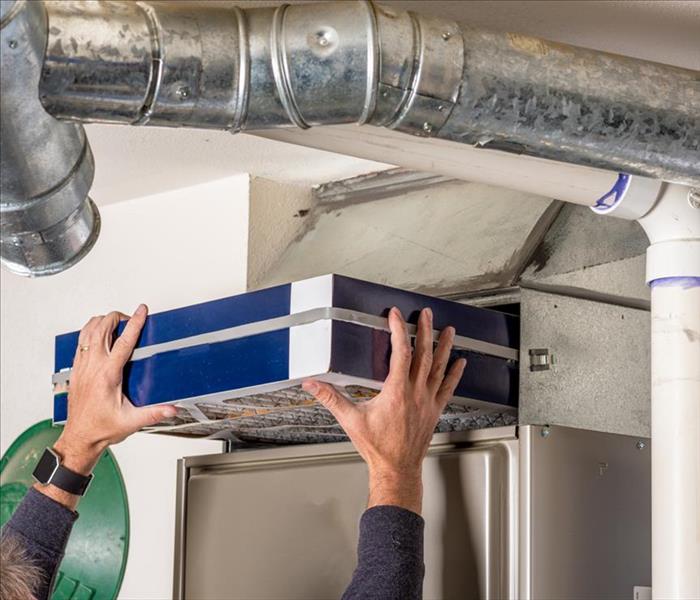 A good furnace requires little more than regular maintenance.
A good furnace requires little more than regular maintenance.
Prevent Furnace Fires
Modern heating systems are typically easy to maintain and trouble-free. Built for efficient operation, a good furnace requires little more than regular maintenance. Without proper upkeep, an inefficient unit could easily catch fire. To keep your furnace in top condition in Liberty, MO, and prevent a possible fire and the resultant fire cleaning, there are several things you can do.
Furnaces Need Space
One of the most common heating system problems is the lack of space. A furnace is often set in an area by itself for a reason. A crowded unit can be a danger to you and your family. These common items can become a fire hazard when placed near the furnace:
- cleaning supplies
- boxes
- brooms
- clothing
A fire can quickly catch from a stray spark onto any of these items and cause considerable damage to your home, and subsequent fire cleaning and restoration is generally no fun at all.
Furnaces Need Attention
There is an old adage that says, “out of sight means out of mind.” Never has that been truer than when applied to furnace filters. This can be a huge problem for busy homeowners who may seldom see the system; it can be easy to forget to provide regular maintenance. Once dirt begins to accumulate on the filter, it can cause the furnace to work inefficiently and overheat. As the filter becomes clogged, it can start a furnace fire with billowing smoke. To prevent smoke cleaning from walls and ceiling, and a possible home fire, inspect furnace filters monthly and replace them as needed.
Furnaces Need Maintenance
These are only two of the many fire hazards associated with a poorly maintained furnace. To prevent possible system damages or fires, contact a technician and schedule an inspection at least once a year. If a furnace fire does occur, that same technician can probably help with the fire cleaning or suggest a fire restoration team that can. Most importantly, keep those filters clean and unclogged to allow your furnace to work efficiently.
How To Maintain a Dryer Vent
7/21/2021 (Permalink)
 Clean the lint filter after every load and dispose of lint.
Clean the lint filter after every load and dispose of lint.
How to Keep a Dryer Vent Clean
It is important to maintain a dryer vent on a regular basis. Completing several tasks that range from clearing the lint filter to snaking out the vent pipe can significantly reduce the risk of a lint fire. Clearing excess lint from the filter, pipe, and area surrounding your dryer is the best way to prevent a dryer fire form breaking out in your home.
1. Clean the lint filter after every load and dispose of lint. This simple step can reduce the amount of lint buildup in the dryer vent pipe and around the dryer.
2. Inspect the back of the dryer for buildup twice a month. Even if you dispose of lint, it may still gather around a dryer. This combustible material raises the possibility of a lint fire breaking out.
3. Snake out the vent pipe every three months. A backed-up vent pipe is a common cause of dryer fires.
4. Brush out the lint filter every six months. Even if you regularly clean the lint filter on your dryer, lint still gets impacted into the mesh of the filter. Using a firm bristled nylon brush can eliminate all traces of lint buildup and keep your filter working at optimal efficiency.
5. Schedule a professional cleaning as soon as your dryer starts taking longer to dry clothes. If your standard cycles are no longer getting your clothing dry, this can be a sign that your dryer is due for more thorough maintenance.
Homeowners report nearly 3,000 dryer fires in the United States every year. These fires are also seasonal, and tend to break out in the fall or winter months. The month of January is notable for a record number of dryer fires. If a lint fire breaks out in your laundry room and damages your home, contact a fire and smoke restoration service located in Liberty, MO.
What To Do if You Smell Natural Gas in the Home
7/15/2021 (Permalink)
 A gas fire can be extremely dangerous and cause major damage to your home.
A gas fire can be extremely dangerous and cause major damage to your home.
Is It Bad If You Can Smell Gas In Your Home
If you are home and smell natural gas, your first instinct may be to panic. After all, you have heard horror stories about homes that have spontaneously combusted because of an undetected gas leak. While you are right to be cautious, you can save your home from a gas fire by acting quickly. The Kansas City, MO, fire restoration team recommends doing the following when you smell gas in your home:
- Check the stove to make sure that it’s off.
- Open all windows and doors to help flush any gases out.
- Keep the lights off.
- Locate your gas meter and check it.
- Get out.
Check for Possible Causes
Oftentimes, the smell of gas isn’t anything to be concerned about. If you have a gas stove, check it first and foremost. Somebody may have bumped a knob in passing or accidentally left a burner on. Turning it off could save you a lot of panic.
Ventilate Your Home
Whether or not you discovered the cause of the smell, open all windows and doors to begin airing out your home. The less gas sitting in your home, the better. A home in which gas is allowed to build up is prone to a gas fire.
Keep the Lights and Electronics Off
Even when you don’t see a visible spark, turning a light switch on generates outward electricity. Even a single spark can ignite the gas and result in a gas explosion. If it’s dark out, use a flashlight.
Check the Gas Meter
If the situation isn’t an emergency one, go outside and check your gas gauge. Turn the valve off until help arrives.
Get Out
The best thing you can do if you smell gas in your home is to get everyone out. Do not take chances on you or your loved ones’ safety and go to a neighbor’s home. Call 911 once you are a safe distance away.
A gas fire can be extremely dangerous, which is why you should act quickly when faced with the smell of natural gas. Be smart in your actions, and a situation doesn’t feel right, get out.
Smart Candle Alternatives
5/24/2021 (Permalink)
 Pour scented oil into the special bottle that is filled with reeds or sticks.
Pour scented oil into the special bottle that is filled with reeds or sticks.
If you love the ambiance of candles but want to avoid a potential candle fire, there are some great candle alternatives available. Flameless candles can add a warm atmosphere to any room in your home.Choices for Ambient Lighting
If you are looking for ambient lighting, battery-powered candles are a great choice. Many of the options look so authentic, you'd never know they weren't the real deal. Some come with a flickering "flame" and a remote control that turns them on and off. You can find models that are shaped to look like the wax has melted, and some are even made with non-toxic wax.
If you are looking to create warmth in a room, battery-operated candles aren’t the only option.
Grab some clean wine bottles and fill them with strings of battery-operated LED lights. Different colored bottles can add to the atmosphere. You can also choose lights in a variety of colors, depending on your mood or the season.
Fairy lights are fun and festive but don't use them just around the holidays. String them around your potted plants, or place them in painted jelly jars.
Scented Options
When you can’t do without the fragrance that scented candles provide, you can find a wide variety of candle alternatives. In addition to scented flameless candles, there are other safe ways to add a pleasant aroma to your home in Gladstone, MO.
Oil warmer - This device is designed to heat fragrant oils and circulate the pleasing scent into the air.
Wax warmer - Fragrant wax is placed onto an electric or battery-powered dish that warms the wax and disperses the aroma.
Stick diffuser - Pour scented oil into the special bottle that is filled with reeds or sticks. The fragrant oil seeps up the stick and out into the air.
To avoid the need for a fire damage assessment, try some of these candle alternatives when you want to add that special ambiance to your home.
Perfecting Your Home Fire Escape Plan
3/25/2021 (Permalink)
 Be sure that you have a fire escape place and practice it often
Be sure that you have a fire escape place and practice it often
Ways To Perfect Your Strategy
If a fire ever occurs in your Kansas City, MO, house, you do not want to be caught unprepared. That is why you should create a fire escape plan. This will help everyone in your homestay calm and know what to do during an emergency. Here are some ways to perfect your strategy.
1. Remove Barriers to Doors or Windows
A basic escape strategy involves identifying two ways out of each room in your house. You need to make sure those exits remain clear at all times. Do not let toys or furniture block doors or windows. You should also avoid nailing or painting over the windows of your home. Finally, if you have security bars on windows or doors, make sure they can be quickly released.
2. Consider Infants, Senior Citizens and Guests
As you make your fire escape plan, keep in mind any members of your household who have mobility issues. Assign one member of your home to assist babies or disabled adults during an emergency. You should also designate a backup person in case the primary individual given this task is not home during the fire.
Similarly, anytime you welcome guests into your home, make sure they know the details of your escape strategy. You should also find out the evacuation strategy for any other houses you or your kids visit.
3. Practice, Practice, Practice
While over 70 percent of Americans have a strategy for escaping a home fire, less than half of those people have practiced it. Emergency drills ensure that everyone understands the plan and help you identify potential faults in that plan. You should run an escape drill twice each year, with one of the tests occurring at night.
With a proper fire preparation strategy, you can keep your family safe during a major blaze. Make a fire escape plan and practice it regularly. In between your drills, keep all doors and windows clear of barriers. You never know when you will need to exit your home quickly.
How To Avoid Grease Fires at Home
12/23/2020 (Permalink)
 Damaged wall after a kitchen grease fire
Damaged wall after a kitchen grease fire
Hot grease has the potential to auto-ignite and is a dense fuel source. Grease fires burn very hot, making this type of blaze one of the most dangerous. To avoid the risk of significant cosmetic or structural damage, homeowners and residents should take the following measures to prevent and quickly extinguish a grease fire that breaks out in the kitchen of a home in Gladstone, MO.
Prepare To Douse Grease Fires
Depriving flames of oxygen is the best way to put out burning grease. Use any of the following methods to douse a grease fire on a home cooktop or range:
- Pour on baking soda and salt
- Cover with a metal lid or sheet pan
- Use a Class B dry chemical fire extinguisher
In general, fire extinguishers are not recommended for grease fires. The force with which suppressant gets expelled can spread flames.
Don’t Leave Hot Oil Unattended
Every cooking oil has an ignition temperature. When this temperature is reached and sustained, grease can light on fire and burn very hot. Many cooking fires start when items are left unattended on a heat source. Never start heating oil in a pan and then leave the kitchen.
Maintain Good Fire Safety Standards
Monitoring food while cooking, keeping combustible items away from stoves, and keeping items on hand for dousing blazes can make major kitchen and cooking fires less likely at a residence. It is also important to protect burner controls from pets and children, as accidental contact often leads to damage that requires fire cleanup.
Being aware of the risk grease fires pose and preparing to put out this type of fire can reduce the risk of major fire damage to a home in Gladstone, MO. Make sure to keep the right ingredients on hand to extinguish a grease fire without spreading flames and take measures to keep hot grease from igniting.
3 Things Commercial Owners Should Expect To See During the Fire Cleanup Process
10/30/2020 (Permalink)
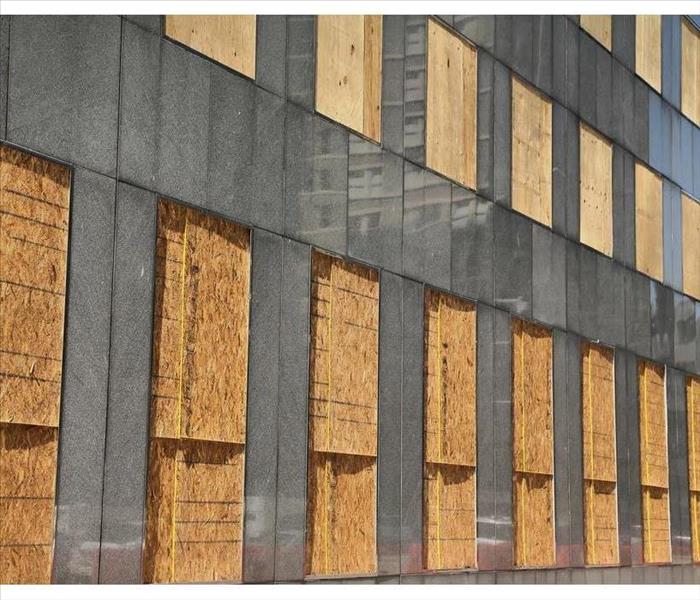 Board up services after fire damage in Gladstone, MO
Board up services after fire damage in Gladstone, MO
Fire Cleanup Process
Once a fire is put out, business owners in Gladstone, MO, begin the tremendous task of recovery. The fire cleanup process takes a while, requiring several stages to remediate concerns from the blaze. Not only do fire restoration companies need to tend to the smoke damage, but they also must safeguard the building, remove odors and tend to water damage. As a result, proprietors should expect to see the following three things during their cleanup procedures.
1. Tarps and Boards
As you survey the property's soot damage, you may notice various holes in the ceiling and walls. Some of these may have been caused by the blaze. Others occurred when the fire crew cut into the drywall, looking for any lingering sparks. Left alone, these exposures leave proprietors vulnerable to theft and harmful weather. These openings, therefore, should be covered and secured to prevent additional destruction and to minimize access.
2. Dehumidifiers
Professionals begin to clean the smoke damage once the excess moisture has been eliminated. After all, sprinkler systems and fire hoses saturated various assets and structural pieces. If allowed to dry naturally, mold can begin to grow. To avoid this complication, industrial dehumidifiers are used to extract excess fluid. These may run for a few days until moisture readers indicate the impacted zone is back within a normal range.
3. Air Scrubbers and Foggers
Along with removing the ash and soot, the rooms should have smoke cleaning deodorizing treatment. Removal of impacted items should occur first. Then, odor technicians can test the reason for strange aromas and use high-tech equipment to eliminate the source. For instance, HEPA filtered air scrubbers can run. These devices remove air pollutants from the space, including the ventilation system. In addition, workers may use a thermal fogger that applies deodorizer sprays that can reach difficult locations.
The professionals can care for your smoke damage. As they do that, they'll also consider other factors. The whole package is needed for proper restoration.
How To Clean Your Gas Range
9/23/2020 (Permalink)
 Clean your gas range
Clean your gas range
Range Cleaning Process
Cooking on a gas range can be messy. Food or oil may splatter from the pans onto the burners. This could be dangerous, as the leftover crumbs or grease might spark a blaze in your Kansas City, MO, home.
Luckily, the range cleaning process is fairly straightforward. Simply follow the below steps, and your range will look as good as new in no time!
1. Clean the Grates and Burner Caps
Remove the grates and burner caps from the range and let them soak in soapy hot water. You can clean off any excess grease using a scrub brush and dish soap.
2. Remove the Crumbs
Next, wipe away any small bits of food on the gas range. You can use either a paper towel or a dry brush for this step.
3. Spray and Wipe
Mix equal amounts of water and vinegar together and put the solution into a spray bottle. Spray the liquid onto the stove top, back panel and knobs. Let the cleaner sit there for about one minute before using a paper towel or rag to wipe the range.
4. Scrub the Stains
Use soap to clean any stains that have been on your stove for a while. Apply dish soap to a toothbrush or small brush. Then put the bristles onto the stain and move the brush in a circular motion.
5. Wash the Burner Heads
Finally, lift the burner heads off the gas range and wash underneath them. Once the debris has been loosened, you can use a small needle or pin to remove it.
Cleaning your range frequently can reduce the chances of a blaze breaking out in your kitchen. Still, a fire can occur even on a spotless stove. The inferno may burn parts of your home and leave behind a nasty odor. If this happens to you, fire damage cleanup specialists can restore your belongings and even remove the smoke smell.
Restoration Services To Protect Your Commercial Property After a Fire
7/6/2020 (Permalink)
 Board up services in Kansas City, MO
Board up services in Kansas City, MO
Restoration Services To Protect Your Commercial Property After a Fire
After surviving the initial fire damage, many business owners do not want to consider that their building may still fall victim to further vandalism and harm. You need to be vigilant after a disaster to protect your facility from looting, vagrants, wildlife, and the weather. A restoration service in Kansas City, MO, can help protect your property through several unique services.
Boarding and Tarping
Fencing
Video Surveillance
In-Person Security
Boarding and Tarping
After a fire ravages your company, it is likely left exposed to the elements. Broken windows, destroyed doors, vent holes in the roof are all consequences of a fire rescue. A restoration company offers boarding and tarping services to seal the interior of your building, protecting from outside elements before the fire cleanup process. They cover roof holes with tarps and seal doorways and windows with plywood sheets.
Fencing
While building owners are primarily concerned with protecting the interior of their facility after fire damage, to provide maximum security from animals and looters, most restoration services suggest using installing a temporary fence. The fencing most often used is construction fencing, which can be removed easily after a full restoration.
Video Surveillance
For property owners who want increased surveillance, some companies offer video surveillance packages. Cameras often act as a deterrent for those who wish to harm your property further. The cameras can be space to eliminate all possible blind spots, ensuring an unobstructed view of the entire property.
In-Person Security
If you want more protection than video cameras and fences, then consider in-person security. While not every mitigation firm will provide or offer this service, they may know of security firms that do. Security guards can be stationed around your property at specific entry points, and they can also walk the facility to eliminate the threat of unwelcome visitors.
Fire damage is only a part of the concern for business and property owners. It is also crucial to protect the building after the fire. Contact a mitigation service for help.
Clay County Smoke and Soot Cleanup
5/25/2020 (Permalink)
 Smoke and soot is very invasive and can penetrate various cavities within your home
Smoke and soot is very invasive and can penetrate various cavities within your home
Smoke and soot is very invasive and can penetrate various cavities within your home or business, causing hidden damage and odor. Our smoke damage expertise and experience allows us to inspect and accurately assess the extent of the damage to develop a comprehensive plan of action.
Smoke and soot facts:
- Hot smoke migrates to cooler areas and upper levels of a structure.
- Smoke flows around plumbing systems, seeping through the holes used by pipes to go from floor to floor.
- The type of smoke may greatly affect the restoration process.
Different Types of Smoke
There are two different types of smoke–wet and dry. As a result, there are different types of soot residue after a fire. Before restoration begins, SERVPRO of Clay County will test the soot to determine which type of smoke damage occurred. The cleaning procedures will then be based on the information identified during pretesting.
Here is some additional information:
Wet Smoke – Plastic and Rubber
- Low heat, smoldering, pungent odor, sticky, smeary. Smoke webs are more difficult to clean.
Dry Smoke – Paper and Wood
- Fast burning, high temperatures, heat rises therefore smoke rises.
Protein Fire Residue – Produced by evaporation of material rather than from a fire
- Virtually invisible, discolors paints and varnishes, extreme pungent odor.
Our Fire Damage Restoration Services
Since each smoke and fire damage situation is a little different, each one requires a unique solution tailored for the specific conditions. We have the equipment, expertise, and experience to restore your fire and smoke damage. We will also treat your family with empathy and respect and your property with care.
SERVPRO of Clay County has been helping families and businesses throughout the Northland with their cleanup and restoration needs for over 25 years.
Have Questions about Fire, Smoke, or Soot Damage?
Call Us Today – (816) 436-7420
Cooking Safety: How to Prevent Kitchen Fires
2/26/2020 (Permalink)
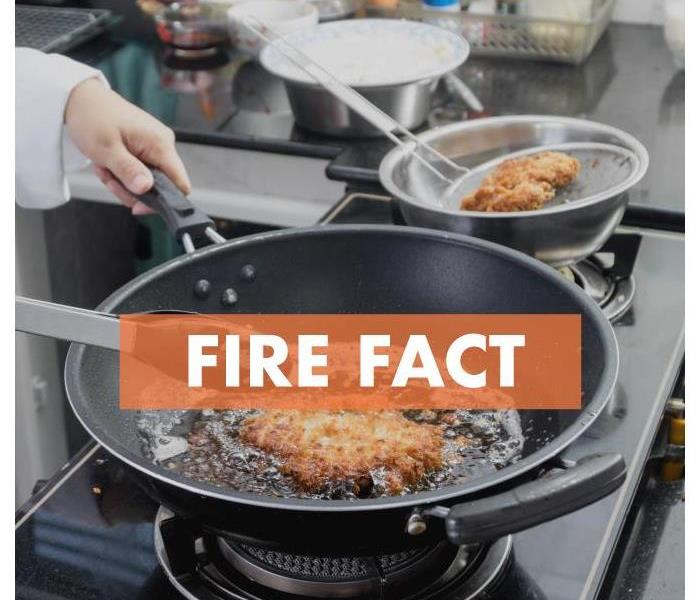 Frying is still the leading activity associated with cooking fires.
Frying is still the leading activity associated with cooking fires.
Common Causes of Kitchen Fires
Cooking fires are the leading cause of fire damage in Gladstone, MO. In fact, the US Fire Department estimates that over 160 000 house fires occur in the United States annually. The majority of them start when flaming food ignites combustible household items such as paper, plastics or curtains.
Here are common causes of kitchen fires:
- Leaving cooking food unattended
- Having combustibles too close to the fire
- Equipment malfunction
Keep an Eye on Cooking Food
Unattended food remains to be the #1 cause of house fires in the nation as food can burst into a big flame when it burns enough. A grease fire, for example, can be easily put out if you are in the kitchen when it starts, but it can get out of hand if it happens while you’re away.
Never Dump Hot Grease in a Garbage Can
It is worth noting that grease can only take so much heat. Smoking is the first sign that it has reached the tipping point and is about to catch fire. Tossing this hot grease could burn something in the trash and result in a fire. Instead, wait for it to cool then put it in an old coffee can before disposing of it. That is one of the overlooked tips that could save you from a fire incident.
Be in a Condition to Cook
Never try to cook under the influence of alcohol. You are obviously slower when intoxicated, and the chances of leaving the cooking food unattended are incredibly high. The same applies to people who are feeling exceedingly sleepy or those who take mind-altering medication. You might not hear about it a lot, but this is one of the most important fire prevention tips.
While cooking might seem hazardous, avoiding it is a bit extreme. Just follow these fire prevention tips religiously, and you will have zero issues.
How to Create a Fire Escape Plan
11/22/2019 (Permalink)
 Be sure that you have a fire escape place and practice it often
Be sure that you have a fire escape place and practice it often
Steps to Create a Fire Escape Plan
When you have children, you likely think about all of the worst case scenarios. You want your children to be as safe and healthy as possible. One of the biggest threats to your home and safety is the risk of a home fire. Fires can be devastating, and can spread quickly. If you have a fire escape plan, it can help ensure kids safety. Here are some things to keep in mind.
Consider Your Family Members
One of the biggest keys to having a successful escape plan is to consider the abilities of everyone in your home. Some may not have the ability to escape the fire on their own. This might include people like:
- Infants or new walkers
- Elderly
- Those with disabilities
These people will likely need extra assistance getting out of the home. Someone should be assigned the task of getting that person safely out of the home.
Plan Escape Routes
Fires are unpredictable, so you may not know which escape routes are available. You should have a minimum of two, so that you have a backup if the primary route is blocked. Keep these paths as clear as possible so it's easy to get out.
Have a Meeting Spot
To eliminate the possibility of someone going missing during a house fire, find a meeting spot that everyone can access easily. For kids safety, make it somewhere that's not too far from the home, but it should be far enough from the danger. A nearby tree or neighbor's house may be a good option.
Practice
Practicing this plan can help you work out any potential issues and make changes. Having drills once a month is a good idea. Remember to adjust the plan as necessary.
With these steps, you should be able to create a fire escape plan to help ensure kids safety, as well as your own. If you do have the misfortune of a fire in Liberty, MO, this plan will help you in a moment of panic. Once the initial shock has settled, contact a professional to help you with fire cleanup.
Which Fire Extinguisher Is Right for Your Home
10/30/2019 (Permalink)
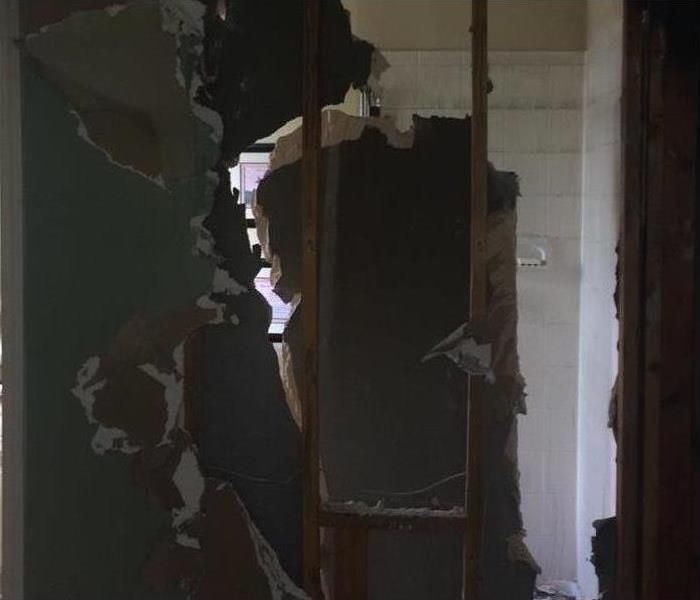 Home fire damage in Gladstone, MO
Home fire damage in Gladstone, MO
Which Fire Extinguisher Is Right for Your Home
While you can't prevent all fires, homeowners can take steps to mitigate them. One such action is ensuring that your family is armed with the proper fire extinguisher to knock out or lesson the flames. It's not as simple, though, as grabbing one from the shelf. You'll want to consider several factors when you make your purchase. Don't leave the store without looking at the size, cost factor and efficiency of the canister.
1. Size
In this case, bigger doesn't always mean better. For example, you could purchase a large ten pound can; however, it might be too heavy for you to use. Therefore, while you're at the store, try lifting it. If it's too heavy, opt for a smaller five-pound extinguisher instead. If a home fire occurs, you need to be able to move it quickly to the location.
2. Cost
After a while, a fire extinguisher can lose effectiveness, and replacing them can add up. Many homeowners purchase disposable one-time use cans. This would require a completely new investment. A rechargeable extinguisher, on the other hand, seems expensive at first, but only require refills. In the long run, it could save you some money.
3. Labels
Before you walk out of the store with a can, read the label carefully. Extinguishers handle three different fires: combustible (A), flammable (B), and electrical (C). As part of your fire preparedness plan, you want one that handles all three, so verify that you see all three letters on the canister. Then, read up on how to use the device properly. If the extinguisher cannot eliminate the flames, then leave the building and allow the fireman to handle the situation. Your life is too important. Locate a fire restoration company in Gladstone, MO, to evaluate your fire damage and clean up the area.
A fire extinguisher is a first line of defense. Be prepared, know how to use it and understand which one is right for your home.
How To Avoid Cigarette Fires In Your Home
7/19/2019 (Permalink)
 Take your cigarette outside
Take your cigarette outside
How To Avoid Cigarette Fires In Your Home
According to the National Fire Protection Association or NFPA, smoking materials, such as cigarettes, contributed to 18,200 home structural fires between 2012 and 2016. Also, during this period, cigarette fires cost an estimated $476 million in direct property damage. Don’t add yourself to the statistics. Find out how to avoid a cigarette fire in your home
1. Smoke outside. Take your cigarette outside. Make yourself a place outside on the back porch with an ashtray or purchase a large outdoor ashtray. These outdoor ashtrays are fire retardant and restrict oxygen to extinguish the cigarette quickly. If used properly, it will also help to keep your yard free of cigarette butts.
2. Put out your cigarette. Always be aware of your cigarette. When you are ready to throw it away, make sure you have totally snuffed it out. Run the butt under water or smother it in sand. Extinguish the cigarette in an ashtray completely to guarantee there are no embers still lit. Use a well-made ashtray, as ashtray fires may occur in a cheaper product.
3. Don’t smoke in bed. Smoking in bed or on the couch is the main contributing cause of cigarette fires. Blankets, sheets, and upholstery easily ignite when a person unknowingly drops a lit cigarette after falling asleep. As a precautionary measure, never smoke in the bedroom, and don’t lay down on the couch with a cigarette in hand.
4. Don’t smoke near oxygen. Not smoking near oxygen may be a no-brainer, but some smokers will continue their habit even when on medical oxygen. The Center for Disease Control estimates 10 to 43% of those on oxygen therapy continue to smoke. There is more chance for severe injury when a cigarette fire occurs near oxygen.
In Kansas City, MO, as in all states around the nation, a cigarette fire not only takes a physical toll but an emotional one as well. Fire cleanup after any fire is a costly undertaking and having to contact a fire damage restoration specialist will add to the total. Pay attention and avoid a controllable situation.
3 Things To Look for in Your Chosen Restoration Company
6/28/2019 (Permalink)
 SERVPRO can handle large jobs
SERVPRO can handle large jobs
Things to Consider When Choosing a Restoration Company
When preparing an emergency plan you may want to choose a fire damage restoration service in Liberty, MO, for your business as knowing who to contact can help you save time in the event that a fire does occur. However, you may be wondering how to select the best company for your needs. There are several things you may wish to consider when choosing the restoration company you wish to work with.
They Offer a Variety of Services
In many cases you may want to choose a restoration company that can offer a variety of services. This will allow them to make any repairs associated with the fire damage including
- Smoke cleanup
- Soot clean up
- Flood water cleanup
- Water damage assessment
- Mold remediation
- Item restoration
- Working with your insurance
They Can Respond Quickly
A professional fire damage restoration service should have the ability to respond quickly as well. This is important as repairs may get in the way of conducting business, and you may want to get everything operational as quickly as possible after a fire. When you contact your chosen service they should be able to get a professional out to you to assess the damage quickly, and then prepare a repair schedule based on the damage type and severity.
They Can Handle Large Jobs
One aspect that may be important for many companies when looking at commercial fire restoration service, is the ability to handle a variety is job sizes. Choosing a company that can do large-scale work often means that in a worst-case scenario they have access to any equipment that may be necessary. It also means that they may be able to handle any job size in between as well.
When choosing the right fire damage restoration team for your business's needs consider the following. What types of services they offer, how quickly they can respond to a disaster, and what size jobs they can handle. Knowing these things before hand will give you a reliable company you can contact in the event that a fired does break out at your business.
When To Clean Your Dryer Vents
5/22/2019 (Permalink)
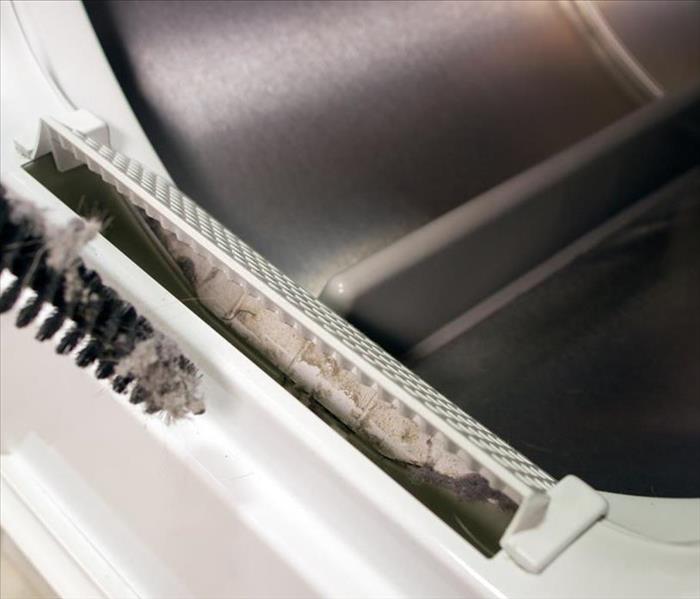 Fires caused by a clothes dryer are more prevalent than you might think
Fires caused by a clothes dryer are more prevalent than you might think
Fires caused by a clothes dryer are more prevalent than you might think, with approximately 2,900 dryer fires reported each year. A lint fire that results from not regularly cleaning the dryer is the leading cause of clothes dryer-related fires. Every time you dry your clothes, lint is collected in your dryer’s vent and lint traps. It is important that you know when to clean them to prevent a fire from starting in your home in Gladstone, MO.
How Often Should You Clean Out Your Vents?
- Empty Filter Before Every Load: Lint is extremely flammable and can quickly overheat and start a lint fire.
- Clean Filter Every Six Months: It is also a good idea to clean the filter with a nylon brush to help combat clogging.
- Clean Out Vent Pipe Every Three Months: Make sure there is no lint in the pipe and check the outside opening for any debris.
- Have a Technician Visit Once a Year: During the visit, the technician will completely clean your vent system and ensure air can flow freely.
How Can You Tell If Your Vent Needs To Be Cleaned?
Your dryer will often let you know if there is an issue with the vents, but it is up to you to quickly take action and prevent a dryer fire. One common indicator that your dryer’s vents are clogged is that your clothes are not drying quickly. Clogged vents can also trap air and moisture inside your laundry room, making it feel hot and humid inside or even produce a musty smell. If your dryer feels hot to the touch after a load, this also is a sign your vents need to be cleaned.
A lint fire can be very dangerous and can cause extensive damage to your home, so regular cleaning and maintenance of your dryer are key. However, if a fire does occur, a fire cleanup company can help address any damage.
Get Out! How to Come up With an Effective Escape Plan
5/5/2019 (Permalink)
 Having an Effective Escape Plan can save lives. Don't wait until it's too late to make your fire escape plan.
Having an Effective Escape Plan can save lives. Don't wait until it's too late to make your fire escape plan.
When disaster strikes, it’s too late to plan and prepare; these things must happen well in advance. Though you, of course, hope to never need to spring a fire escape plan into action, having one in place can save lives. If you don’t have such a plan in your Kansas City, KS, office, or if you haven’t reviewed yours in a while, make this a priority today.
How to Come up With an Effective Escape Plan
Meet Together
An emergency escape plan is at its best when it has input from several key people. This isn’t a plan you or someone else should come up with on a whim. It requires a group discussion and varying ideas.
• Consider selecting an emergency response committee.
• Meet regularly to review past plans and determine what improvements you should make.
• Open the group to your organization; invite people to participate who have experience or expertise in devising such plans.
Know Your Space
If a fire starts in your building, it’s vital that everyone exits in a calm and orderly manner. Employees must be swift, however, and this means they need to know how and where to properly exit. Identify all possible exits on each floor and in all areas of your building.
Assign Roles
You can’t have a mad rush for the stairs or the doors if you need to evacuate the building. You also want someone to sweep the building for stragglers and someone else to count people once you’re outside. Make sure someone is covering these important duties.
Practice Makes Perfect
No fire escape plan should be complete without holding consistent drills. At least annually, practice exiting the building and meeting at a designated spot in a safe location near your building.
Don’t wait until it’s too late to make your fire escape plan. Firefighters and restoration crews will do their jobs. Make sure you do yours too.
3 Things To Know About Lightning and House Fires
2/5/2019 (Permalink)
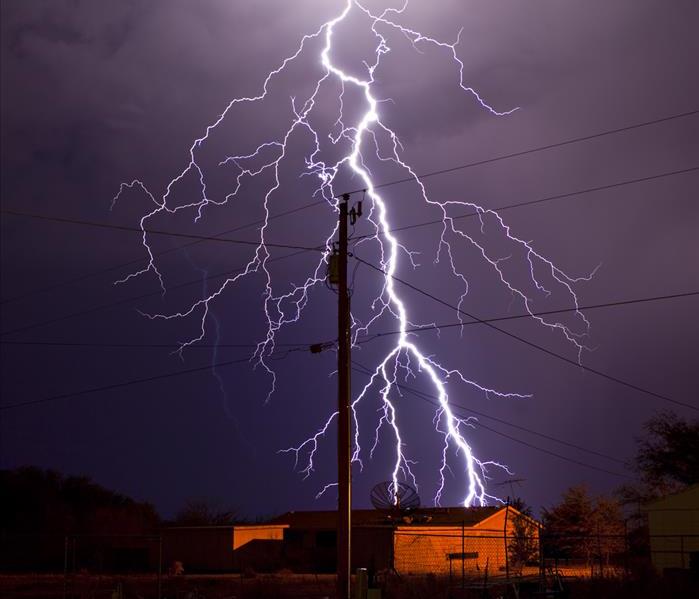 In general, a lightning fire is more likely to occur during the summer when storms occur.
In general, a lightning fire is more likely to occur during the summer when storms occur.
3 Things To Know About Lightning and House Fires
A lightning fire can occur quickly and can devastate your home in Kansas City, MO. There are many misconceptions about these types of fire, however, and learning more about these types of fires can help you feel more prepared to react in the event of a fire.
1. Damage to Your Home Is More Likely Than Injury
When lightning strikes, a house fire is often the result; it is relatively uncommon for a person to be struck. In the United States, fewer than 60 people were injured by strikes in four years. However, a significant amount of damage was done to homes in that time period due to fires that occurred as a result of a strike. Unplugging appliances in your home can help to reduce the likelihood of your home being struck.
2. The Time of Year and Environment Matters
In general, a lightning fire is more likely to occur during the summer when storms occur. Additionally, certain environments are more susceptible to fires that are caused by lightning. Areas that are experiencing drought are more likely to see these types of fires since dry grasses and shrubbery can quickly ignite and spread, which can result in extensive damage to the area.
3. Preparation and Education Can Be Useful
If you are outside when a storm begins, there are steps you can take to that can help keep you safe. Keeping away from water and keeping your distance from tall trees and power lines can reduce the likelihood of being struck. If you are inside when a storm occurs, keeping away from windows can also be beneficial. Additionally, knowing how to react if any type of fire occurs in your home can help to keep you and others safe.
Understanding the damage a lightning fire can cause, knowing when this type of fire is likely to occur and knowing how to react during a storm can help you take steps to protect yourself. If your home has been affected by this type of fire, it can be useful to contact fire and storm restoration experts.
Fire Alarms: The ABCs of Smoke Detection
12/26/2018 (Permalink)
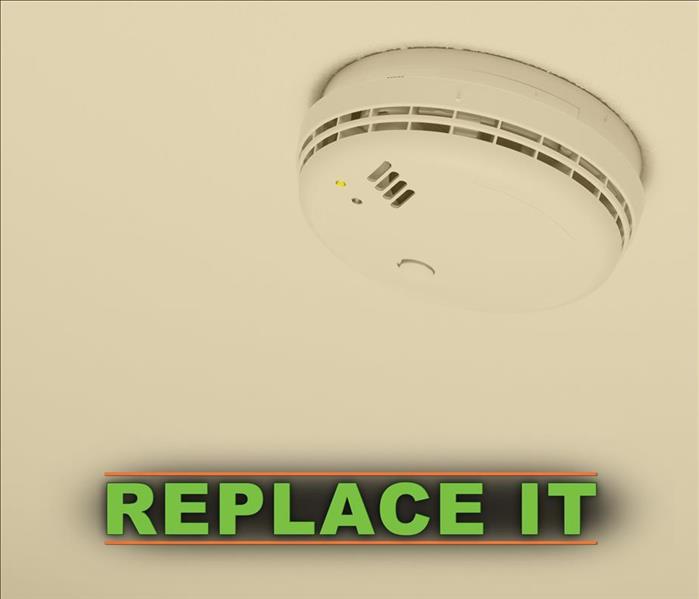 You should replace your smoke detectors every 8 to 10 years
You should replace your smoke detectors every 8 to 10 years
Smoke Alarm Questions
The fact is a fire alarm can save lives and every home should have more than one. That’s right houses are supposed to have more than one alarm. In order to better prepare yourself for a potential emergency, it is essential to know the answers to the most frequently asked smoke alarm questions.
1. How many smoke alarms do you need?
While people tend to concern themselves over the possibility of fire and smoke damage, they should be more concerned with the number of alarms in their homes. You should have a signal in every bedroom and outside of every bedroom. You should also have smoke alarms installed on every level of your home. Keep in mind that this is the minimum and that you may want to have more.
2. How often should you replace the batteries?
The general rule is that you should replace fire alarm batteries at least once a year. Granted, the instructions may state that the batteries have a longer shelf life, but it is always better to be safe than sorry.
3. When should you replace the smoke detector?
In order to provide the greatest defense against fire damage, you should replace your smoke detectors every 8 to 10 years. Obviously, this is dependent on the type of alarm and any guarantees. To keep track of the timeline, you can write the date of purchase on the alarm and even record it in a calendar app with a reminder to replace.
4. What type of smoke detector should you use?
While you can reach out to the fire department or a fire restoration company in the Gladstone, MO, area to learn about the specific types of fire detectors, each can be put into two categories: ionized and photoelectric. Each one provides different strengths and weaknesses depending on the kind of fire and smoke, which is why you should have a mix of detectors in your home.
A fire alarm is a life-saving tool. Be sure to install them in your home today, for the safety of you and your loved ones.
How To Avoid a Fire During a Natural Gas Leak
10/24/2018 (Permalink)
If you smell gas in your Liberty, MO, home, it could be a sign that there is a leak. This type of leak could put you at risk for a gas fire. Avoiding a fire may be difficult, but it can be done. Consider these five tips if you ever have to deal with gas leakage, but remember that it may be safer for you to simply evacuate your house and call emergency responders.
1. Avoid creating a spark
When natural gas fills your home, the smallest spark could start an explosion. You can avoid causing sparks by not turning lights on, using candles or making calls on a cellphone.
2. Start airing out the space
If the gas is not allowed to build up in your home, you may lower your risk of a gas explosion. Opening doors and windows increases the ventilation and helps the gas dissipate.
3. Check obvious sources
If you have time, you can check some obvious sources of a natural gas leakage. This usually includes appliances that run on gas. Stoves are the most common culprit as it is easy for someone to bump a burner on accident.
4. Turn off the gas
When you hear a hissing sound or smell rotten eggs, you can turn off your home's gas. The valve is usually located by the meter.
5. Know the signs of a leak
Before a gas fire can happen, there usually has to be a leak. You can avoid the fire if you can put a stop to the leak quickly. Common signs of a leak include hissing air, blowing dirt, rotten egg smell and bubbling puddles.
It may not always be possible for you to avoid a gas fire. When the unexpected happens, you need to know who to call for help. A residential fire cleanup crew can help you get your life back to normal.
Sometimes the Smoke Lingers in Places Unexpected
5/29/2018 (Permalink)
Unexpected Damage
Experts in fire repair and restoration are often trained to investigate unexpected areas where smoke damage can collect. This includes closets, drawers, window ledges, and behind draperies. The professionals often learn that the hot, soot and smoke-filled air rapidly invades the cooler air inside, under, and behind objects. That is because as the molecules heat, they can be sucked into unheated areas as soot collects onto unexpected surfaces causing considerable damage.
Smoke also collects in unexpected places such as under nail heads, behind pictures, in brick crevices, inside light fixtures, and under glass covers of tables and desks. Office plants can similarly conceal smoke as it clings to leaves, moss, and plastic containers. Smoke can also penetrate the paint on walls, lacquer on furniture, and wooden doors and window frames.
Mysterious Smoke
Restoration after a fire can take time because smoke damage can often be more extensive than the flame or water damage. In the end, smoke is typically neither random nor erratic. Physics can help restoration specialiststake the mystery out of smoke cleaning and get the building open quickly.
For more information, please visit us at http://www.SERVPROclaycounty.com/.




 24/7 Emergency Service
24/7 Emergency Service




















